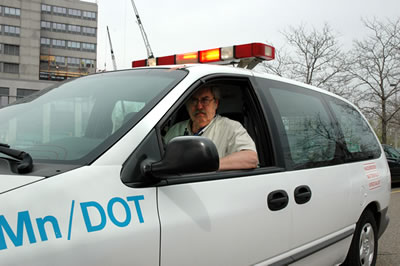By Nick Carpenter

Michael Ritchie is one of four hazardous materials specialists in the Office of Freight & Commercial Vehicle Operations. Their top priority is responding to hazmat transportation incidents, which include the release or potential release of hazmat cargo at a crash or during the loading or unloading of a truck. Photo by Nick Carpenter |
Michael Ritchie’s path to becoming a hazardous materials specialist began in 1984, when he was hired by the department to serve as a motor transportation representative.
At that time, there were only two hazmat specialist positions within the agency and both were occupied. The positions were relatively new, having been created in 1980 due to federal hazmat regulations adopted by the state of Minnesota. Although the regulations were in place before 1980, not many of the states were enforcing them, according to Ritchie.
In 1988, Ritchie applied for and became the agency’s third hazmat specialist. For 21 years he has held his position, making him the most senior member of the current crew of hazmat specialists, which also includes Jim Fox, Kevin Kampa and Randy Kudzia.
What are your daily duties?
Most people think that hazmat specialists deal mainly with emergency response. In reality, only part of our duties pertain to emergency response issues.
Hazmat specialists conduct compliance reviews, hazmat cargo inspections and provide hazmat and motor carrier safety training.
I also spend a lot of time answering hazmat questions from the industry and interested citizens, as well as coordinating our activities with the USDOT and various state agencies.
What you do when responding to an emergency?
We are dispatched by the Minnesota Duty Officer, who works for the Department of Public Safety and is the single point for requesting state agency assistance and reporting hazmat spills. We are on-call 24 hours a day, seven days a week.
When we arrive at an incident, we have two primary responsibilities.
The first is to be part of the incident command system and provide support and technical expertise to the incident commander. The incident commander is usually the local fire chief or emergency manager.
We work closely with other state agencies at an incident scene and provide knowledge and experience in hazmat packaging, including the design of cargo tanks, procedures for product transfer and up-righting rolled-over vehicles. The goal is to get the incident handled safely, prevent or reduce chemical releases and get the highway reopened.
Second, we figure out why the incident happened by performing an investigation to determine if the incident was caused or made more serious by violations of the hazardous material or motor carrier safety regulations.
If hazmat shipper or carrier violations are discovered, we document them and refer the responsible shipper or carrier for regulatory review. The review may direct the responsible party to take immediate corrective action to prevent further violations or unsafe activities.
What type of incidents do you respond to?
We have responded to a variety of incidents over the years.
Our top priority is hazmat transportation incidents, which include the release or potential release of hazmat cargo at a crash or during the loading or unloading of a truck.
Transloading mishaps occur when hazardous material leaks during the transfer of cargo from a truck to rail car or vice versa.
We also deal with fires or chemical releases that occur at a facility near a highway, illegal dumping of hazmat on the right of way or any other incident that affects a road or highway.
In cases where someone has illegally dumped hazardous material on Mn/DOT right of way, we attempt to identify the guilty party. Every once in awhile, we get lucky and are able to trace the material back to the responsible party.
Who cleans up the mess?
It is the duty of the responsible party to prevent discharges, clean up all spilled material and dispose of the waste properly.
However, department policy allows maintenance workers to contain and remove vehicle fluids, but not hazmat cargo, to get a roadway open.
Describe an interesting incident you or your team responded to.
My partner, Jim Fox, responded to a BLEVE on Hwy 7 in Olivia last year just before Thanksgiving. A BLEVE, which is very rare, is an incident that involves a boiling-liquid-expanding-vapor explosion.
The incident involved a driver who turned his propane cargo tanker over causing it to rupture and explode. That’s extremely unusual because propane cargo tanks are generally tough.
I responded to a gasoline tanker rollover on Hwy 75 in Lac Qui Parle County in February. The trucker was driving in white out conditions, lost sight of the road and ran into the ditch.
I checked with District 8 staff and the State Patrol and was told travel in the area was unsafe. Local responders who made it to the scene reported the tanker was not leaking so we decided to leave the truck where it was, as it was unsafe for recovery crews to operate.
I then contacted the trucking company and we scheduled the recovery effort for the next day. The following morning I supervised the off-loading of the cargo tank and, thankfully, no gasoline was spilled.
Do you or a co-worker have an interesting job to share with readers? Click here to send us your ideas, and we’ll contact you for more information.
Recent employee profiles:
|



